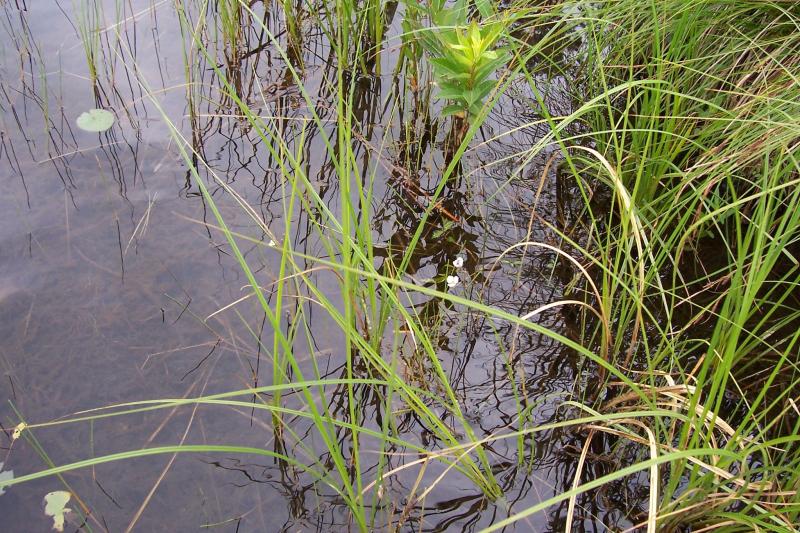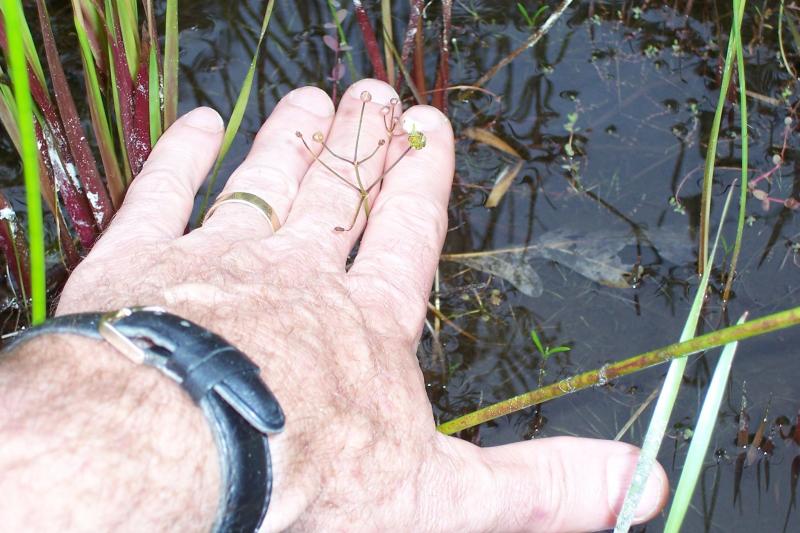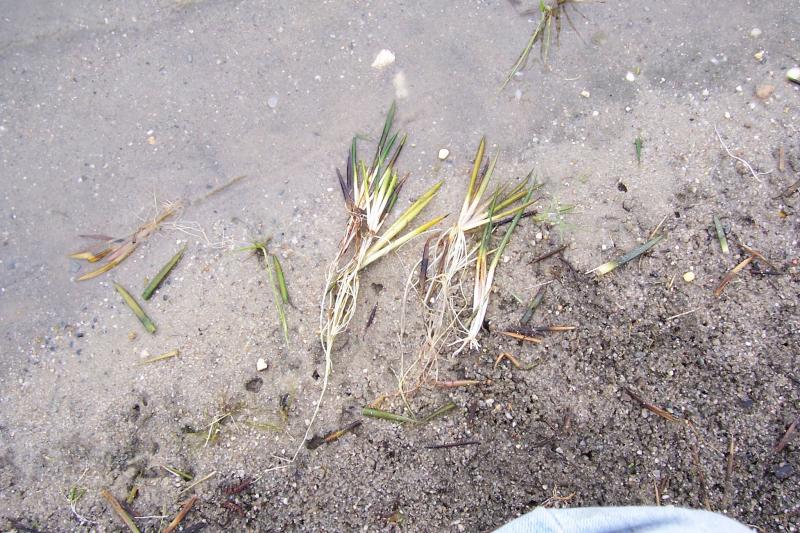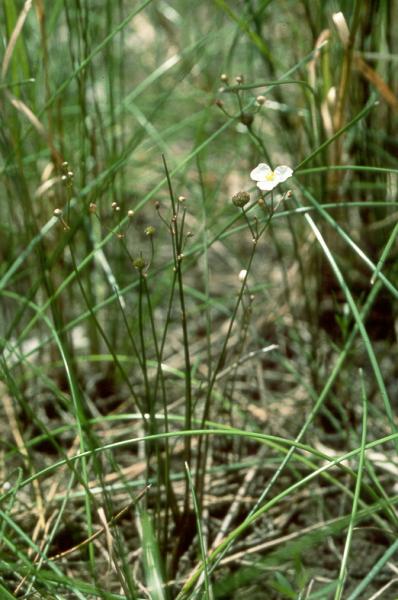Quill-leaved Arrowhead
Sagittaria teres S. Wats.
- Class
- Monocotyledoneae (Monocots)
- Family
- Alismataceae (Water-Plantain Family)
- State Protection
- Endangered
Listed as Endangered by New York State: in imminent danger of extirpation in New York. For animals, taking, importation, transportation, or possession is prohibited, except under license or permit. For plants, removal or damage without the consent of the landowner is prohibited.
- Federal Protection
- Not Listed
- State Conservation Status Rank
- S1
Critically Imperiled in New York - Especially vulnerable to disappearing from New York due to extreme rarity or other factors; typically 5 or fewer populations or locations in New York, very few individuals, very restricted range, very few remaining acres (or miles of stream), and/or very steep declines.
- Global Conservation Status Rank
- G3
Vulnerable globally - At moderate risk of extinction due to rarity or other factors; typically 80 or fewer populations or locations in the world, few individuals, restricted range, few remaining acres (or miles of stream), and/or recent and widespread declines.
Summary
Did you know?
The species name is Latin for cylindrical and refers to the quill-like leaves that are cylindrical in cross-section, unlike other leaves in the genus (Fernald 1950). It was first described and named by Sereno Watson, a 19th century botanist from Connecticut who worked at the Harvard Gray herbarium (Library of the Gray Herbarium 2008).
State Ranking Justification
There are two large existing populations which consist of multiple, hydrologically connected ponds. There are two historical populations from the 1920s which have not been resurveyed and two additional populations that are considered extirpated.
Short-term Trends
The short-term population trend appears stable after being resurveyed in 2005, although a couple of them could not be relocated. This may be due to high water levels since short-term trends are often difficult to assess for plants in coastal plain ponds because of fluctuating water levels.
Long-term Trends
The ong-term trend appear stable since this plant has always been rare and is still found at locations that have been known for over 100 years. However, plants at a couple of locations have been extirpated.
Conservation and Management
Threats
Some ponds have seen direct disturbance by trampling and ATV use but this threat seems to have diminished in recent years. The invasion of Phragmites is also a threat to a few populations.
Conservation Strategies and Management Practices
The pondshores need protection from direct disturbance by ATVs and excessive trampling. Exotic invasive species must be prevented from colonizing new shore areas and any present populations must be eliminated. A natural buffer of at least 200 feet should be established around the ponds to prevent excessive runoff and pollution events.
Habitat
Habitat
In New York this species occurs exclusively in the shallow water of coastal plain pondshores often among larger emergent vegetation (New York Natural Heritage Program 2012).
Associated Ecological Communities
- Coastal plain pond shore
(guide)
The gently sloping shore of a coastal plain pond with seasonally and annually fluctuating water levels. Plants growing on the pond shore vary with water levels. In dry years when water levels are low there is often a dense growth of annual sedges, grasses, and herbs. Submerged and floating-leaved aquatic plants, such as fragrant waterlily and pondweeds, may become "stranded" on the exposed shore. In wet years when the water level is high only a few emergents and floating-leaved aquatics may be noticeable. T
Associated Species
- Eleocharis equisetoides (horsetail spike-rush)
- Eleocharis robbinsii (Robbins's spike-rush)
- Eleocharis tricostata (three-ribbed spike-rush)
- Hypericum canadense (lesser Canadian St. John's-wort)
- Juncus militaris (bayonet rush)
- Nymphaea odorata
- Pontederia cordata (pickerelweed)
- Utricularia
- Xyris smalliana (Small's yellow-eyed-grass, large yellow-eyed-grass)
Range
New York State Distribution
This wetland wildflower is only known from Suffolk County on Eastern Long Island.
Global Distribution
It is rare throughout its range. It grows from New Jersey to Long Island and north to Rhode Island, Massachusetts, and New Hampshire.
Identification Comments
General Description
Quill-leaf arrowhead is an aquatic plant with erect stems growing 1-8 dm tall from long slender rhizomes. The leaves grow 3-20 cm long from the base of the plant and are tubular, chambered, and long pointed without separate blades. The branching inflorescence has 2-4 whorls of flowers on slender, ascending to spreading pedicels 1-3 cm long. The upper flowers are staminate and the lower ones are pistillate but only one or two produce fruit. The flowers have sepals that are reflexed in fruit and white petals 3-6 mm long. The 12-15 stamen filaments are roughened with minute scales. The achenes are 2-3 mm long with 1-3 prominent toothed wings on each face and a wing on the top. The beak is erect to horizontal (Gleason and Cronquist 1991).
Best Life Stage for Proper Identification
This species can be identified with leaf characters only although it is best to see it in flower or fruit when it can be distinguished from surrounding vegetation.
Similar Species
Two other Sagittaria species occur within the range of Sagittaria teres. Sagittaria engelmanniana has large arrow-shaped leaf blades and filaments that are smooth. Sagittaria graminea has bladeless leaves that are flat and not chambered and often produces larger leaves with blades (Gleason and Cronquist 1991).
Best Time to See
The best time to identify this plant is in July through September.
- Flowering
- Fruiting
The time of year you would expect to find Quill-leaved Arrowhead flowering and fruiting in New York.
Quill-leaved Arrowhead Images
Taxonomy
Quill-leaved Arrowhead
Sagittaria teres S. Wats.
- Kingdom Plantae
- Phylum Anthophyta
- Class Monocotyledoneae
(Monocots)
- Order Alismatales
- Family Alismataceae (Water-Plantain Family)
- Order Alismatales
- Class Monocotyledoneae
(Monocots)
- Phylum Anthophyta
Additional Resources
Best Identification Reference
Crow, Garrett E. 1982. New England's Rare, Threatened, and Endangered Plants. Prepared for the United States Department of Interior, Fish and Wildlife Service, Northeast Region. June 1982.
Other References
Gleason, Henry A. and A. Cronquist. 1991. Manual of Vascular Plants of Northeastern United States and Adjacent Canada. The New York Botanical Garden, Bronx, New York. 910 pp.
Hellquist, C.B. and G.E. Crow. 1981. Aquatic vascular plant. New Hampshire Agricultural Experiment Station University of New Hampshire. Station Bulletin 518.
Holmgren, Noel. 1998. The Illustrated Companion to Gleason and Cronquist's Manual. Illustrations of the Vascular Plants of Northeastern United States and Adjacent Canada. The New York Botanical Garden, Bronx, New York.
House, Homer D. 1924. Annotated list of the ferns and flowering plants of New York State. New York State Museum Bulletin 254:1-758.
Mitchell, Richard S. and Charles J. Sheviak. 1981. Rare Plants of New York State. Bull No. 445. New York State Museum. Univ. of New York. State Ed. Department Albany, NY.
New York Natural Heritage Program. 2010. Biotics database. New York Natural Heritage Program. New York State Department of Environmental Conservation. Albany, NY.
New York Natural Heritage Program. 2024. New York Natural Heritage Program Databases. Albany, NY.
Ogden, E.C. 1974. Anatomical patterns of some aquatic vascular plants of New York. New York State Museum Bull. 424.
Taylor, Norman. 1915. Flora of the vicinity of New York. Memoirs of the New York Botanical Garden vol. V. New York, NY.
Weldy, T. and D. Werier. 2010. New York flora atlas. [S.M. Landry, K.N. Campbell, and L.D. Mabe (original application development), Florida Center for Community Design and Research http://www.fccdr.usf.edu/. University of South Florida http://www.usf.edu/]. New York Flora Association http://newyork.plantatlas.usf.edu/, Albany, New York
Links
About This Guide
This guide was authored by: Stephen M. Young
Information for this guide was last updated on: September 6, 2012
Please cite this page as:
New York Natural Heritage Program. 2024.
Online Conservation Guide for
Sagittaria teres.
Available from: https://guides.nynhp.org/quill-leaf-arrowhead/.
Accessed July 27, 2024.



